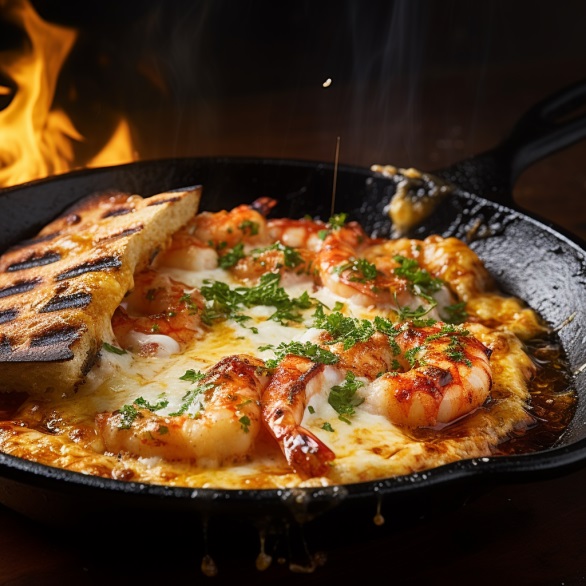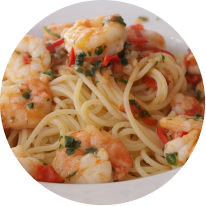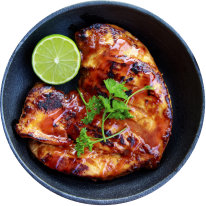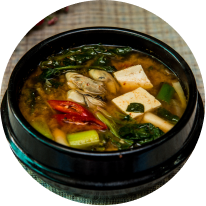Overview of Greek Flaming Cheese (Introduction)
What is Greek Flaming Cheese? Greek flaming cheese, known as Saganaki, is a beloved Greek appetizer that has gained popularity worldwide. It is characterized by its unique preparation method, which involves flambéing the cheese to create a spectacular flame and a delicious melted cheese dish. Saganaki is not only a delight for the taste buds but also a visual feast.
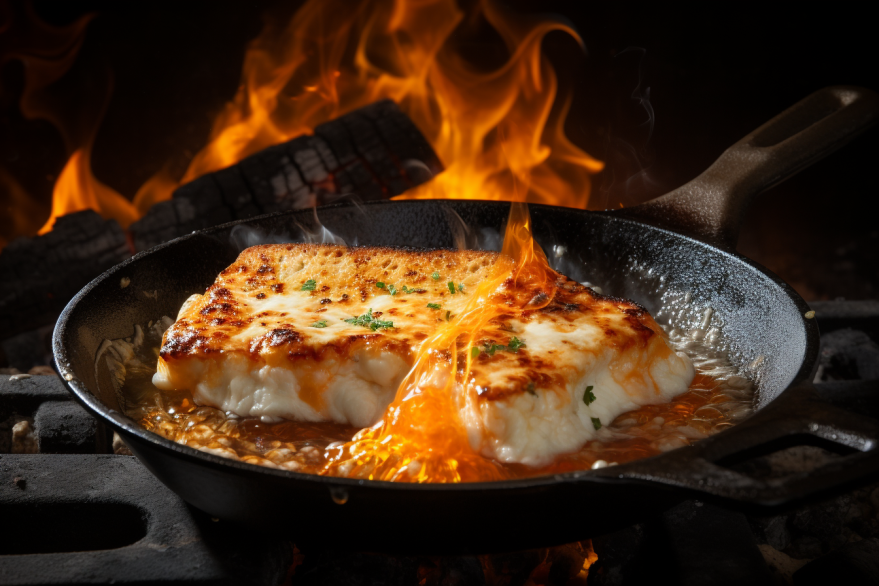
When it comes to Greek cuisine, Saganaki holds a special place as one of the most iconic appetizers. It showcases the rich culinary heritage of Greece and the vibrant flavors that Greek cuisine has to offer. If you’re looking to explore authentic Greek recipes and learn more about Greek culinary traditions, Cooking With Greek People is a fantastic resource. Their website provides a wide range of Greek recipes, including Saganaki, and insights into the history and heritage of Greek food.
What is Greek Flaming Cheese, Saganaki?
Saganaki is a traditional Greek appetizer made with various types of cheese, such as Kefalotyri, Kasseri, or Halloumi. It gets its name “flaming cheese” from the flambéing process involved in its preparation.To make Saganaki, a slice of cheese is dipped in cold water to prevent sticking and then coated with flour. The cheese slice is then pan-fried in olive oil until it develops a golden-brown crust on both sides.
The key to achieving the perfect Saganaki is choosing the right cheese. Kefalotyri, Kasseri, and Halloumi are commonly used cheeses for this appetizer. These cheeses are selected for their ability to hold their shape while melting inside, resulting in a crispy exterior and a gooey interior. Saganaki is typically served with lemon wedges, which add a tangy flavor that complements the richness of the melted cheese. The dish is best enjoyed by spreading the melted cheese on bread or pita.
Types of Cheeses Used in Saganaki
When it comes to Saganaki, the choice of cheese plays a crucial role in determining the flavor and texture of the dish. Kefalotyri, Kasseri, and Halloumi are commonly used cheeses for Saganaki. Kefalotyri is a hard, salty cheese made from sheep or goat milk, providing a robust flavor to the dish. Kasseri, on the other hand, is a semi-hard cheese with a tangy taste. Halloumi, known for its unique texture that allows it to be grilled or fried without melting, is another popular choice.
The selection of cheese can vary based on personal preference and availability. Some variations of Saganaki may even incorporate feta cheese, which adds a distinct flavor to the dish. Ultimately, the choice of cheese depends on the desired taste and the cheese’s ability to hold its shape while melting.
Preparation and Serving of Saganaki
To prepare Saganaki, the cheese slice is first dipped in cold water, which prevents it from sticking to the pan during frying. The cheese is then coated with flour, creating a thin layer that contributes to the crispy crust. The cheese slice is pan-fried in olive oil until it forms a golden-brown crust on both sides.
For those seeking a more dramatic presentation, the cheese can be flambéed with brandy or ouzo. This step adds a touch of excitement as the alcohol ignites, creating a stunning flame. The flames are extinguished by squeezing lemon juice over the cheese, further enhancing the flavors. Saganaki is traditionally served hot to preserve the gooey texture of the melted cheese.
Saganaki is often enjoyed with bread or pita, which serves as the perfect vessel for scooping up the warm, melted cheese. The combination of the crispy exterior, the creamy interior, and the tangy lemon creates a harmonious flavor profile that keeps people coming back for more.
Pairing and Serving Suggestions
Saganaki is commonly served as part of a mezze spread or appetizer platter in Greek cuisine. It pairs well with a variety of other Greek dishes, such as Greek meatballs, stuffed grape leaves, zucchini fritters, tzatziki, and spanakopita. These complementary flavors create a well-rounded and satisfying dining experience.
To balance out the richness of the cheese, Saganaki can be enjoyed alongside a refreshing salad, such as a Greek salad. The crispness and acidity of the salad complement the creamy and savory nature of the dish. Saganaki is a versatile appetizer that can be shared among 2-4 people, depending on the portion size and the number of accompanying dishes.
If you’re interested in exploring more Greek recipes and serving suggestions, Cooking With Greek People offers a wide range of resources on their website. From traditional Greek dishes to breakfast options and grilled meat recipes, their website is a treasure trove of Greek culinary traditions.
History and Cultural Significance of Saganaki
Saganaki has a long history in Greek cuisine, with variations of fried cheese dishes found in different regions. The flaming version of Saganaki, which adds a theatrical element to the dish, is a Greek-American creation. The dish takes its name from the small frying pan called “saganaki” in Greek, traditionally used to prepare it.
Saganaki is a beloved appetizer that showcases the rich culinary heritage of Greece. It is enjoyed both in Greece and around the world, as people embrace the warm and vibrant flavors of Greek cuisine. Cooking With Greek People provides insights into the history and heritage of Greek food, allowing readers to delve deeper into the origins of Saganaki.
Conclusion
What is Greek flaming cheese, known as Saganaki, is a popular Greek appetizer made with various types of cheese. Its flambéing process creates a spectacular flame and a delicious melted cheese dish that is enjoyed by many. If you’re eager to explore Greek cuisine and learn more about authentic Greek recipes, visit the Cooking With Greek People website at cookingwithgreekpeople.com. Discover the warmth of Greek culinary traditions and let the vibrant flavors of Greece inspire your cooking.
What is Greek Flaming Cheese? Tastes of Greek in Laguna Niguel, California answers that question.
Discover the Finest Feta Cheeses for Your Greek Feast Indulge in the rich flavors and creamy textures of Greece’s finest feta cheeses. From tangy and crumbly to smooth and savory, explore our top picks for the best feta cheeses that will elevate your culinary creations to new heights. Read more
Master the Art of Perfect Greek Saganaki: A Culinary Delight Unleash your inner chef and impress your guests with the perfect Greek saganaki. Learn the secrets to achieving golden perfection and savor the irresistible flavors of this iconic Greek dish. Read more
Exploring the Variety of Greek Cheese: A Journey Through Tradition and Taste Embark on a culinary journey through Greece’s diverse cheese landscape. From creamy feta to tangy graviera, discover the rich flavors and cultural significance of Greek cheese varieties. Read more
Unveiling the Secrets of Graviera Cheese from Crete: A Taste of Tradition Delve into the rich history and robust flavors of Graviera cheese from Crete. Learn about the time-honored techniques used to craft this beloved Greek cheese and savor its unique taste profile. Read more
Kefalotyri Cheese: Elevate Your Culinary Creations with Greek Excellence Experience the bold flavors and creamy textures of Kefalotyri cheese. Discover how this versatile Greek cheese can enhance your favorite dishes and elevate your culinary creations to new heights. Read more
Mizithra Cheese: A Culinary Treasure of Greece Unlock the secrets of Mizithra cheese and discover its unique flavor and versatility. From savory pies to decadent desserts, explore creative ways to incorporate this beloved Greek cheese into your culinary repertoire. Read more
Ladotyri Cheese: A Taste of Greece’s Culinary Heritage Indulge in the rich flavors and textures of Ladotyri cheese, a true symbol of Greece’s culinary heritage. Learn about the traditional methods used to craft this beloved Greek cheese and explore its culinary versatility. Read more
Anthotyros Cheese: Exploring the Delicate Flavors of Greece Experience the delicate flavors and creamy textures of Anthotyros cheese, a beloved staple of Greek cuisine. Discover its culinary versatility and explore creative ways to incorporate this exquisite Greek cheese into your favorite dishes. Read more
Tastes of Greece, Laguna Niguel California




